Development of the Low-Pressure Die Casting Process for an Aluminium Alloy Part
Abstract
:1. Introduction
2. Materials and Methods
2.1. Materials
2.2. Low Pressure Die Casting
2.3. Characterisation
2.4. Numerical Simulation
3. Experimental Results and Discussion
3.1. Numerical Simulation Results
3.2. Mechanical Properties
3.2.1. Tensile Testing
3.2.2. Hardness Testing
3.3. Microstructure
3.4. Porosity Analysis
4. Conclusions
- The use of numerical simulation proved to be valuable as the experimental results confirmed the findings of the simulations. The porosities identified in the experimental work were most likely of gaseous origin (hydrogen porosities), and therefore undetectable by the used software (ProCAST 18.0);
- The use of a rotor for degassing paired with the LPDC process showed positive results, resulting in total average porosities of 0.62% with very small average pore sizes (0.072 mm2);
- While optical microscopy is an important tool for the microstructural characterisation of castings, it is short-lived and it is necessary to complement it with technologies such as EDS (energy-dispersive X-ray spectroscopy) or SEM (scanning electron microscopy) in order to draw more concrete conclusions, with the results attained on this end in this work being achieved through comparison rather than by analysis;
- When analysing the results from the LPDC tensile tests and hardness tests, it can be concluded that the produced LPDC castings’ mechanical properties are of acceptable quality, with further work regarding their thermal treatment (T6) being required to evaluate the parts in their full working condition.
Author Contributions
Funding
Institutional Review Board Statement
Informed Consent Statement
Data Availability Statement
Acknowledgments
Conflicts of Interest
References
- Santana, C.; Reyes-Osorio, L.; Orona-Hinojos, J.; Huerta, L.; Rios, A.; Zambrano-Robledo, P. Numerical Study of Reinforced Aluminum Composites for Steering Knuckles in Last-Mile Electric Vehicles. World Electr. Veh. J. 2024, 15, 109. [Google Scholar] [CrossRef]
- Li, F.; Sun, J.; Bao, J.; Yang, J.; Li, H.; Zhong, C.; Gao, Y.; He, Q.; Xie, K.; Li, W. Failure analysis of truck steering knuckle. Eng. Fail. Anal. 2022, 140, 106537. [Google Scholar] [CrossRef]
- Pugazhenthi, R.; Anbuchezhiyan, G.; Muthuraman, R.K.; Vignesh, M.; Ponshanmugakumar, A. Optimization of fatigue life and fractography analysis of knuckle joint. Mater. Today Proc. 2021, 46, 4344–4348. [Google Scholar] [CrossRef]
- Hasan, A.; Lu, C.; Liu, W. Lightweight Design and Analysis of Steering Knuckle of Formula Student Car Using Topology Optimization Method. World Electr. Veh. J. 2023, 14, 233. [Google Scholar] [CrossRef]
- Reza Kashyzadeh, K. Effects of Axial and Multiaxial Variable Amplitude Loading Conditions on the Fatigue Life Assessment of Automotive Steering Knuckle. J. Fail. Anal. Prev. 2020, 20, 455–463. [Google Scholar] [CrossRef]
- Živković, V.; Adamović, D.; Nedić, B. Quantitative methods for steering knuckle material selection. Mobil. Veh. Mech. 2021, 47, 1–12. [Google Scholar] [CrossRef]
- Kadam, S.R.; Ghadage, M.M.; Kale, P.D. Design and Weight Optimization of Critical Automobile Component-Steering Knuckle. In Techno-Societal 2020, Springer: Cham, Switzerland, 2021.
- Abdullah, S.; Ullah, M.; Shareef, O. Design and Multi-Axial Load Analysis of Automobile Steering Knuckle. Carbon 2018, 3, 525–530. [Google Scholar]
- Aydin, R.; Akdogan, A.; Durakbasa, M.N.; Vanli, A.S. Castability of Steering Knuckle from Aluminium Alloy by Low Pressure Die Casting Replacing Sand Casting of Cast Iron. Acta Tech. Napoc.-Ser. Appl. Math. Mech. Eng. 2021, 64, 579–589. Available online: http://hdl.handle.net/20.500.12708/136591 (accessed on 13 December 2023).
- Ou, J.; Wei, C.; Logue, S.; Cockcroft, S.; Maijer, D.; Zhang, Y.; Chen, Z.; Lateng, A. A study of an industrial counter pressure casting process for automotive parts. J. Mater. Res. Technol. 2021, 15, 7111–7124. [Google Scholar] [CrossRef]
- Uyan, T.Ç.; Otto, K.; Silva, M.S.; Vilaça, P.; Armakan, E. Industry 4.0 Foundry Data Management and Supervised Machine Learning in Low-Pressure Die Casting Quality Improvement. Int. J. Met. 2023, 17, 414–429. [Google Scholar] [CrossRef]
- Liu, L.; Zhou, W.; Liu, F.; Peters, G.H.; Zhang, Y.; Song, C. Melt Quality of A356.2 Alloy in the Pressure Counter Pressure Casting Process for Steering Knuckles. Int. J. Met. 2024, 18, 1247–1261. [Google Scholar] [CrossRef]
- Sonsino, C.M.; Franz, R. Multiaxial fatigue assessment for automotive safety components of cast aluminium EN AC-42000 T6 (G-AlSi7Mg0.3 T6) under constant and variable amplitude loading. Int. J. Fatigue 2017, 100, 489–501. [Google Scholar] [CrossRef]
- Beeley, P.R. Foundry Technology, 2nd ed.; Butterworth Heinemann: Oxford, UK; Boston, MA, USA, 2001; p. 719. [Google Scholar]
- Fu, P.; Luo, A.A.; Jiang, H.; Peng, L.; Yu, Y.; Zhai, C.; Sachdev, A.K. Low-pressure die casting of magnesium alloy AM50: Response to process parameters. J. Mater. Process. Technol. 2008, 205, 224–234. [Google Scholar] [CrossRef]
- Campbell, J. Chapter 16—Casting. In Complete Casting Handbook, 2nd, ed.; Campbell, J., Ed.; Butterworth-Heinemann: Boston, MA, USA, 2015; pp. 821–882. [Google Scholar] [CrossRef]
- Kridli, G.T.; Friedman, P.A.; Boileau, J.M. 7—Manufacturing processes for light alloys. In Materials, Design and Manufacturing for Lightweight Vehicles; Mallick, P.K., Ed.; Woodhead Publishing: Cambridge, UK, 2010; pp. 235–274. [Google Scholar] [CrossRef]
- Liu, S.-G.; Cao, F.-Y.; Zhao, X.-Y.; Jia, Y.-D.; Ning, Z.-L.; Sun, J.-F. Characteristics of mold filling and entrainment of oxide film in low pressure casting of A356 alloy. Mater. Sci. Eng. A 2015, 626, 159–164. [Google Scholar] [CrossRef]
- Puga, H.; Barbosa, J.; Azevedo, T.; Ribeiro, S.; Alves, J.L. Low pressure sand casting of ultrasonically degassed AlSi7Mg0.3 alloy: Modelling and experimental validation of mould filling. Mater. Des. 2016, 94, 384–391. [Google Scholar] [CrossRef]
- Yavuz, H.; Ertugrul, O. Numerical Analysis of the Cooling System Performance and Effectiveness in Aluminum Low-Pressure Die Casting. Int. J. Met. 2021, 15, 216–228. [Google Scholar] [CrossRef]
- Nath, J. Aluminum Castings Engineering Guide; ASM International: Almere, The Netherlands, 2018. [Google Scholar]
- Bonollo, F.; Urban, J.; Bonatto, B.D.; Botter, M. Gravity and low pressure die casting of aluminium alloys: A technical and economical benchmark. La Mettallurgia Ital. 2005, 6, 23–32. [Google Scholar]
- Abdullin, A.D.; Ershov, A.A. End-to-End Simulation of Casting and Metal-Forming Operations with ProCAST and Qform Software. Metallurgist 2014, 58, 339–345. [Google Scholar] [CrossRef]
- Zhao, Y.; Zhang, B.; Hu, X. Design and Verification of a New Test Bar Die for LPDC Process Based on Numerical Simulation. Int. J. Mech. Eng. Robot. Res. 2020, 9, 1240–1245. [Google Scholar] [CrossRef]
- Ou, J.; Wei, C.; Cockcroft, S.; Maijer, D.; Zhu, L.; Lateng, A.; Li, C.; Zhu, Z. Advanced Process Simulation of Low Pressure Die Cast A356 Aluminum Automotive Wheels—Part I, Process Characterization. Metals 2020, 10, 1418. [Google Scholar] [CrossRef]
- Panzhong, L.; Ning, L. Low pressure casting technology and forming process analysis of metal mold based on ProCAST FEA procedure. Mech. Adv. Mater. Struct. 2022, 29, 1308–1315. [Google Scholar] [CrossRef]
- Dillibabu, S.P.; Vasudevan, B.; Megaraj, M.; Palanivel, A.; Durvasulu, R.; Manjunathan, K. Aluminum and its alloys in automotive and aerospace applications review. AIP Conf. Proc. 2023, 2766, 020027. [Google Scholar] [CrossRef]
- Hren, I.; Kusmierczak, S.; Naprstková, N.; Horky, R. Eutectic Modification of Al-Si Alloys by Using AlSr10. In Innovations in Mechanical Engineering II; Springer: Cham, Switzerland, 2023. [Google Scholar]
- Srinivas, B.; Janardhana, R. Effect of strontium modifier on the microstructure, mechanical properties and fractography analysis of as-cast Al-Si7Mg0.3 alloy. Adv. Mater. Process. Technol. 2023, 1–16. [Google Scholar] [CrossRef]
- Sunitha, K.; Gurusami, K. Study of Al-Si alloys grain refinement by inoculation. Mater. Today Proc. 2021, 43, 1825–1829. [Google Scholar] [CrossRef]
- Dobkowska, A.; Adamczyk-Cieślak, B.; Mizera, J.; Kurzydłowski, K.J.; Kielbus, A. The Comparison of the Microstructure and Corrosion Resistance of Sand Cast Aluminum Alloys. Arch. Metall. Mater. 2016, 61, 209–212. [Google Scholar] [CrossRef]
- Závodská, D.; Tillová, E.; Švecová, I.; Chalupová, M.; Kuchariková, L.; Belan, J. The Effect of Iron Content on Microstructure and Porosity of Secondary AlSi7Mg0.3 Cast Alloy. Period. Polytech. Transp. Eng. 2018, 47, 283–289. [Google Scholar] [CrossRef]
- Schoß, J.P.; Keßler, A.; Dommaschk, C.; Szucki, M.; Wolf, G. Precipitation of Iron-Containing Intermetallic Phases from Aluminum Alloys by Metal Melt Filtration. In Multifunctional Ceramic Filter Systems for Metal Melt Filtration: Towards Zero-Defect Materials; Aneziris, C.G., Biermann, H., Eds.; Springer International Publishing: Cham, Switzerland, 2024; pp. 787–813. [Google Scholar] [CrossRef]
- Xi, H.H.; Xu, J.J.; Yuan, X.; Ming, W.Q.; Zhang, Z.; Chen, J.H. The ill-defined π(AlFeMgSi) phase intermetallics formed in an automotive Al-Si-Mg alloy. Mater. Charact. 2023, 199, 112839. [Google Scholar] [CrossRef]
- Kreins, M.; Hippe, M.; Funken, F.; Phyu, M.P.; Bührig-Polaczek, A.; Krupp, U. Effect of Shrinkage Versus Hydrogen Pores on Fatigue Life of Cast AlSi11Mg Alloy. Int. J. Met. 2024. [Google Scholar] [CrossRef]
- Samuel, A.M.; Samuel, E.; Songmene, V.; Samuel, F.H. A Review on Porosity Formation in Aluminum-Based Alloys. Materials 2023, 16, 2047. [Google Scholar] [CrossRef]
- Hu, M.; Sun, D.; Zhu, M. Simulation of gas porosity formation and interaction with dendrite and eutectic structures during solidification of Al-Si alloys. Mater. Des. 2024, 241, 112977. [Google Scholar] [CrossRef]
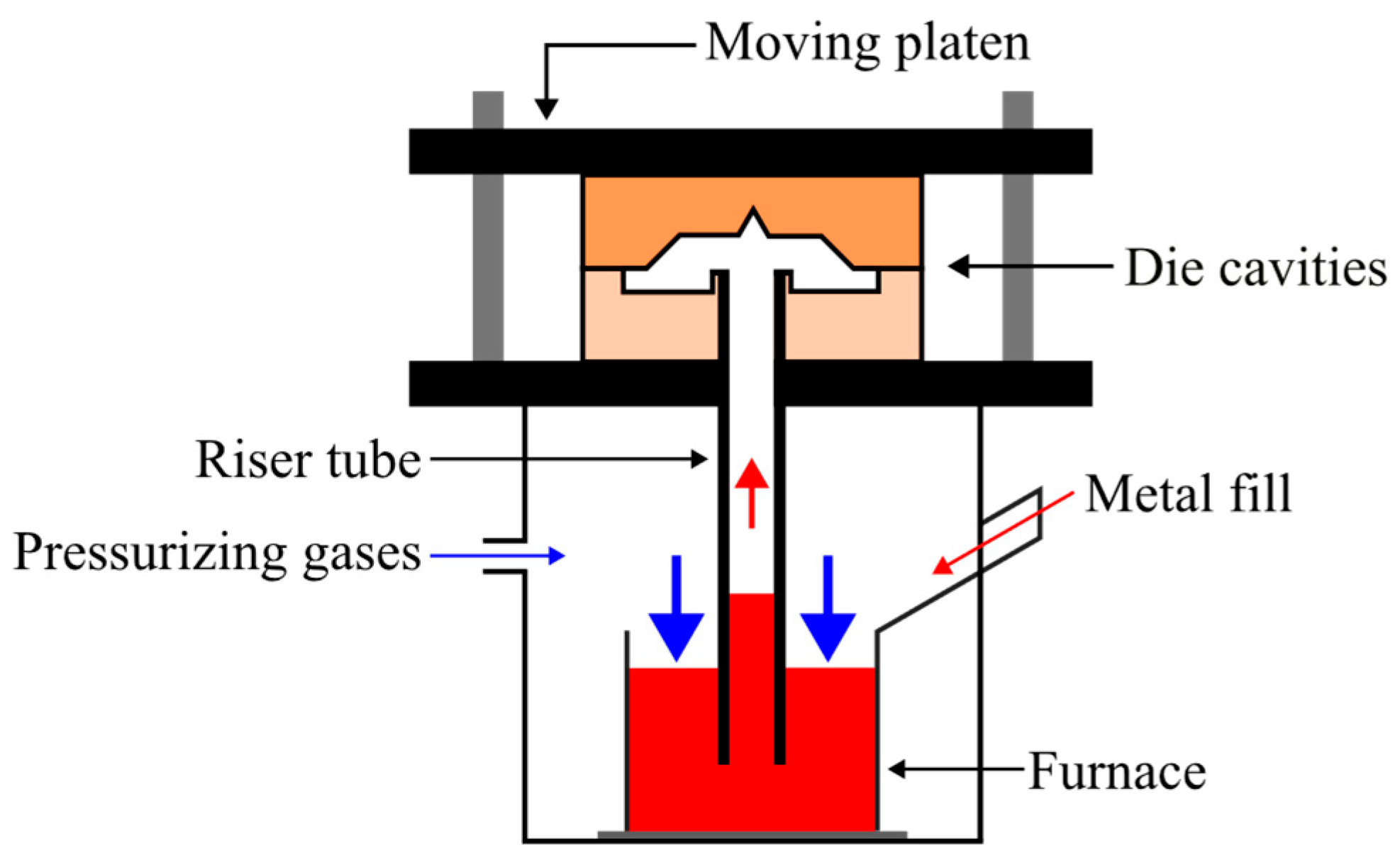
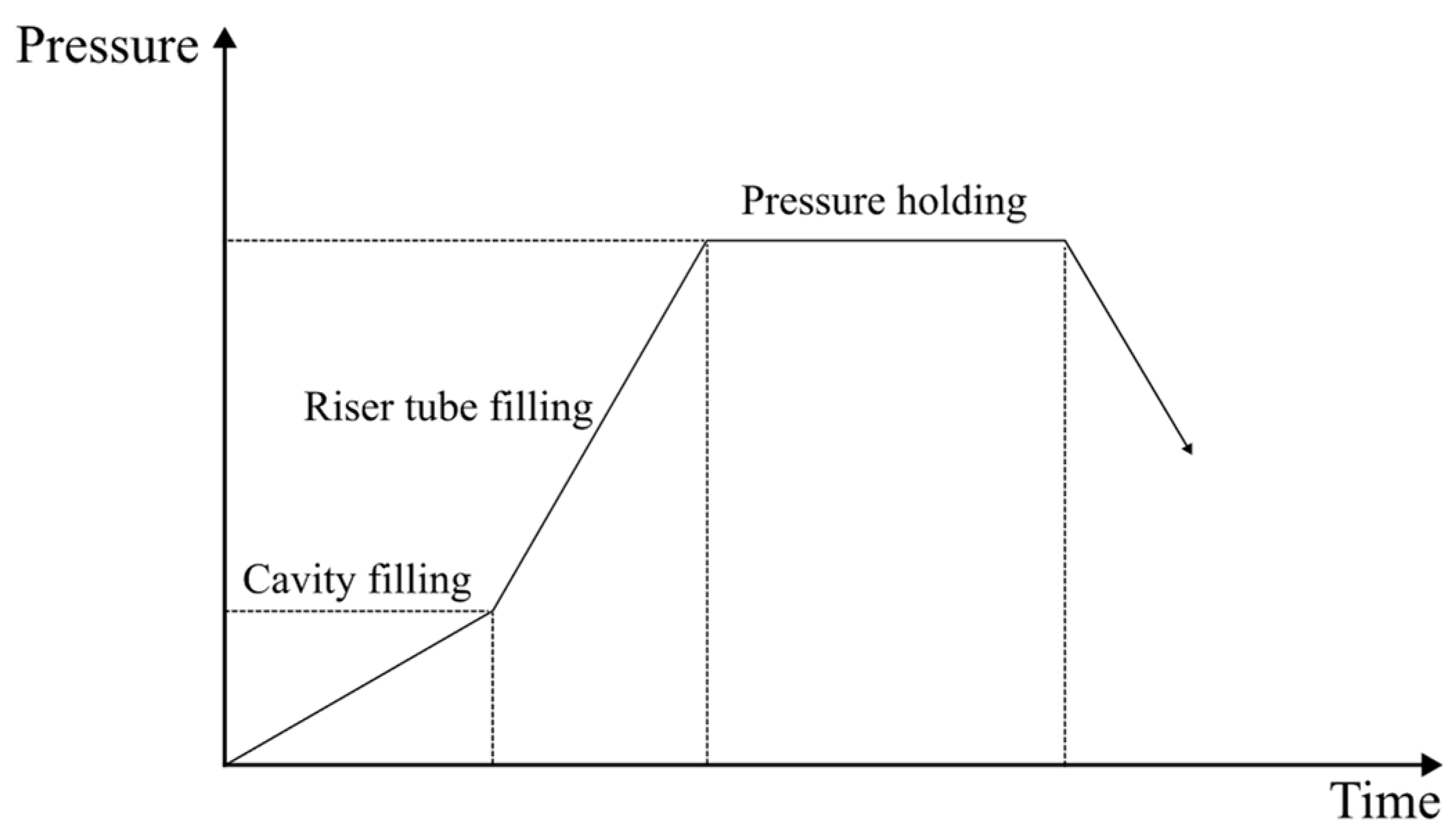
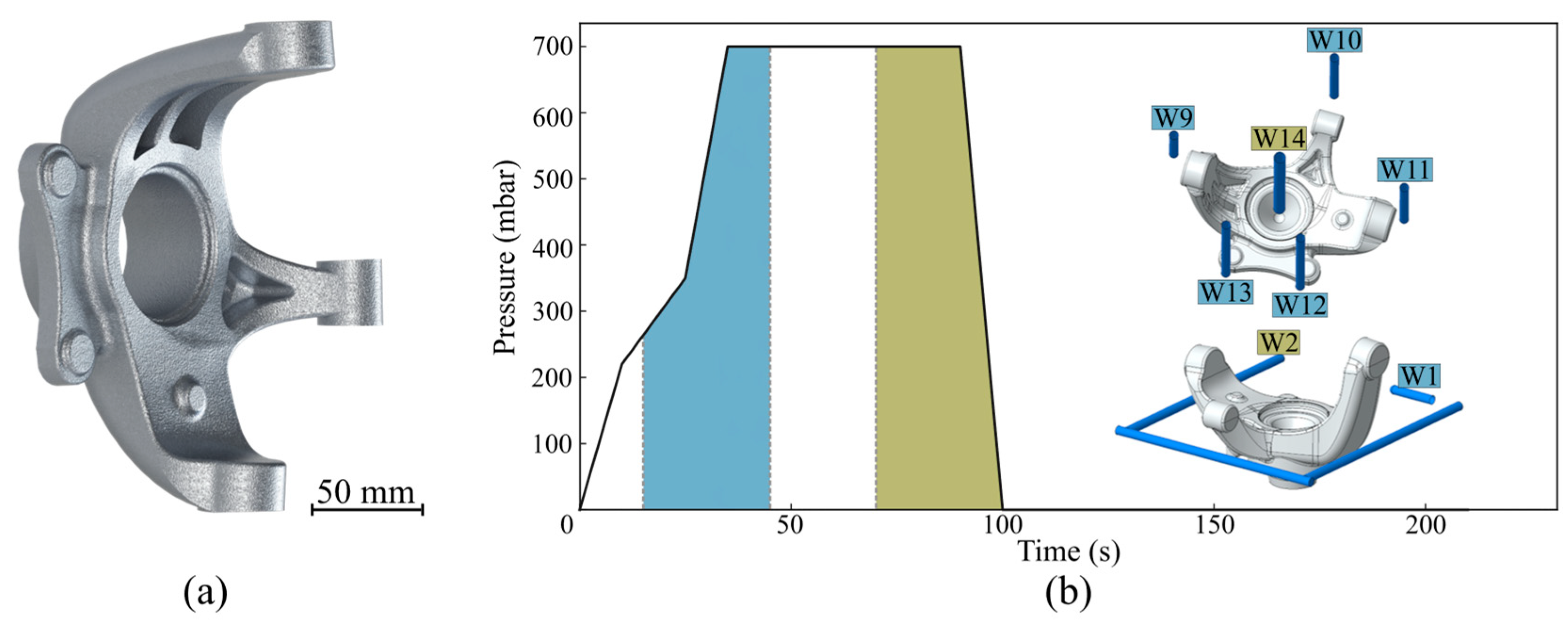
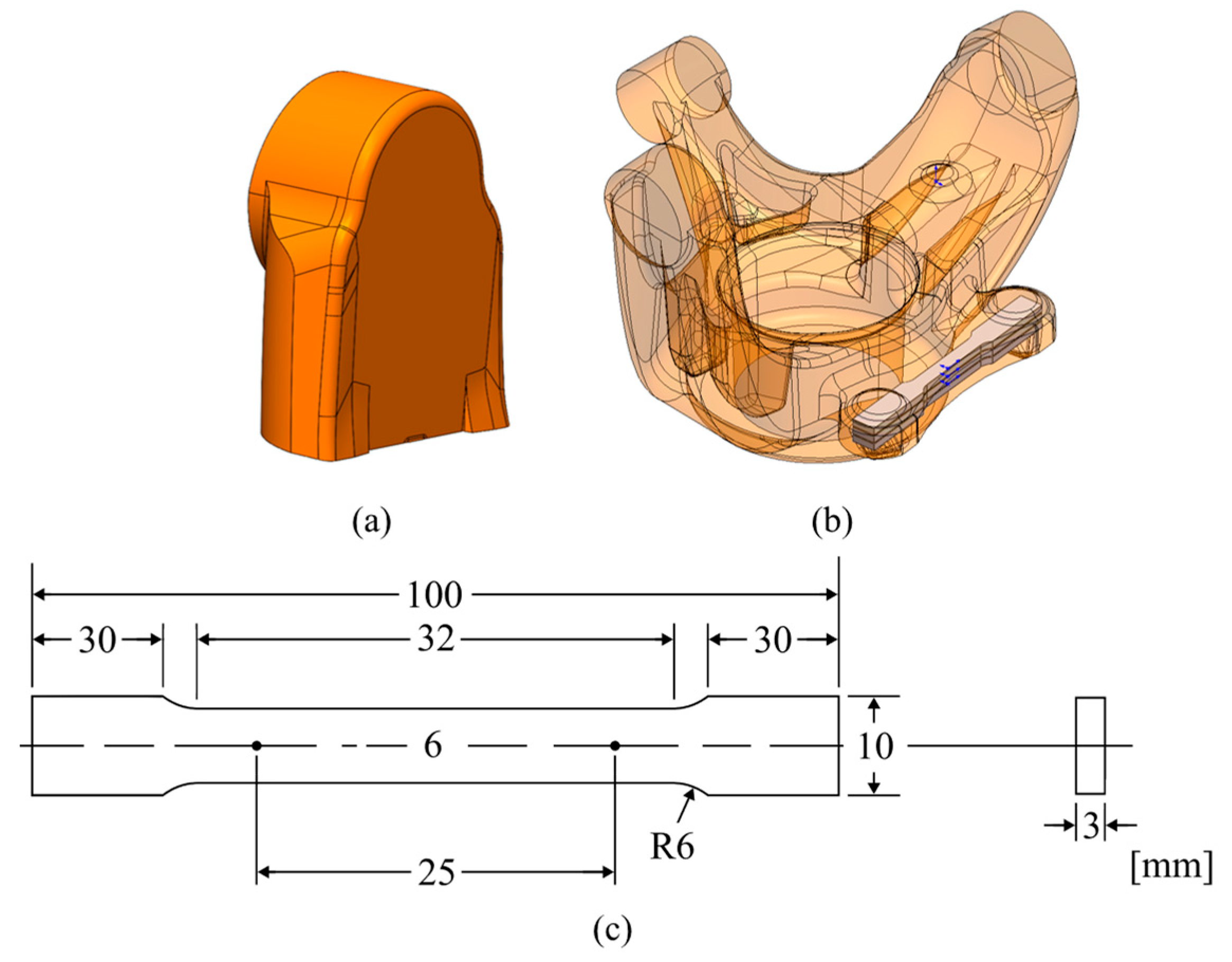
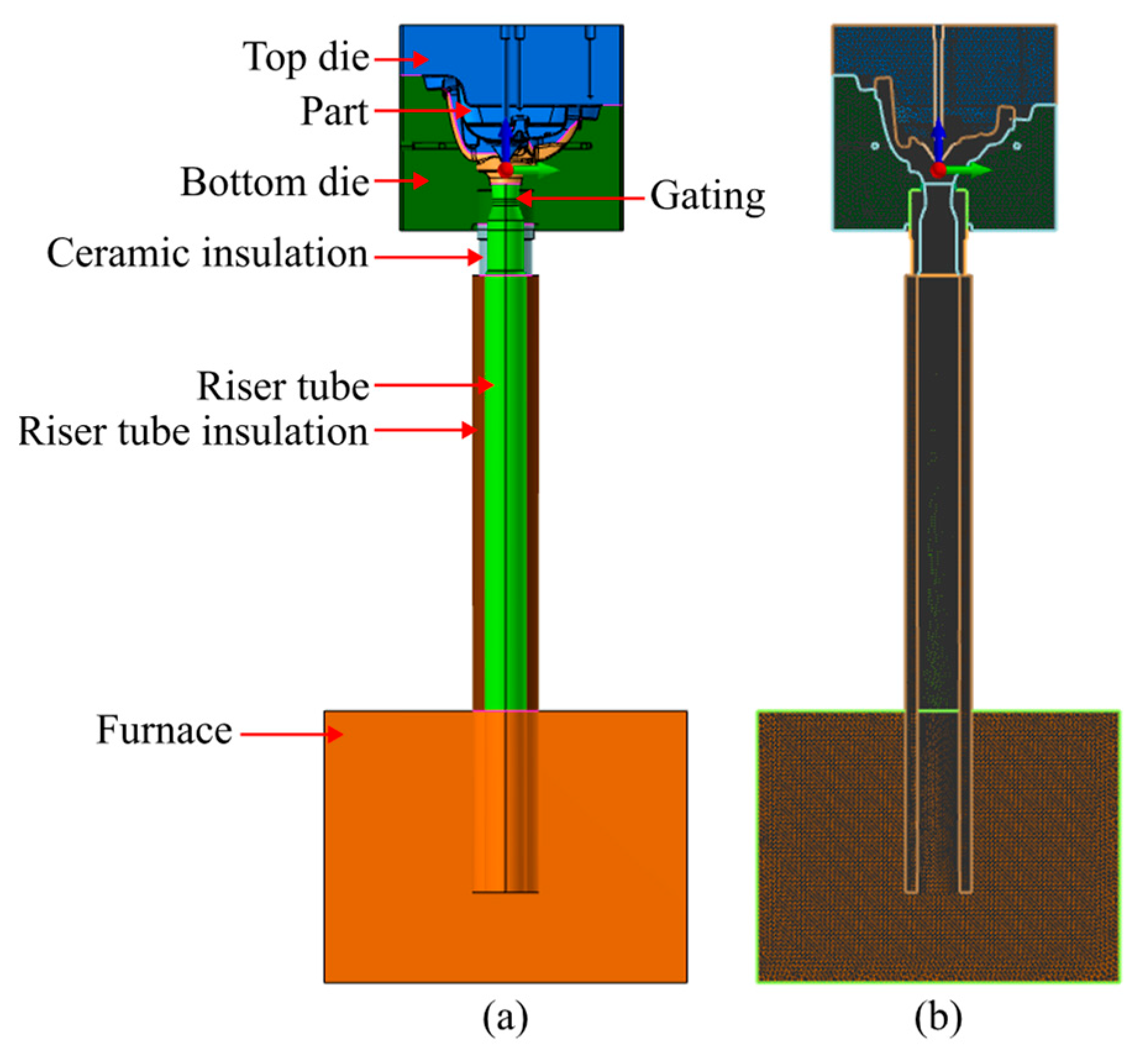
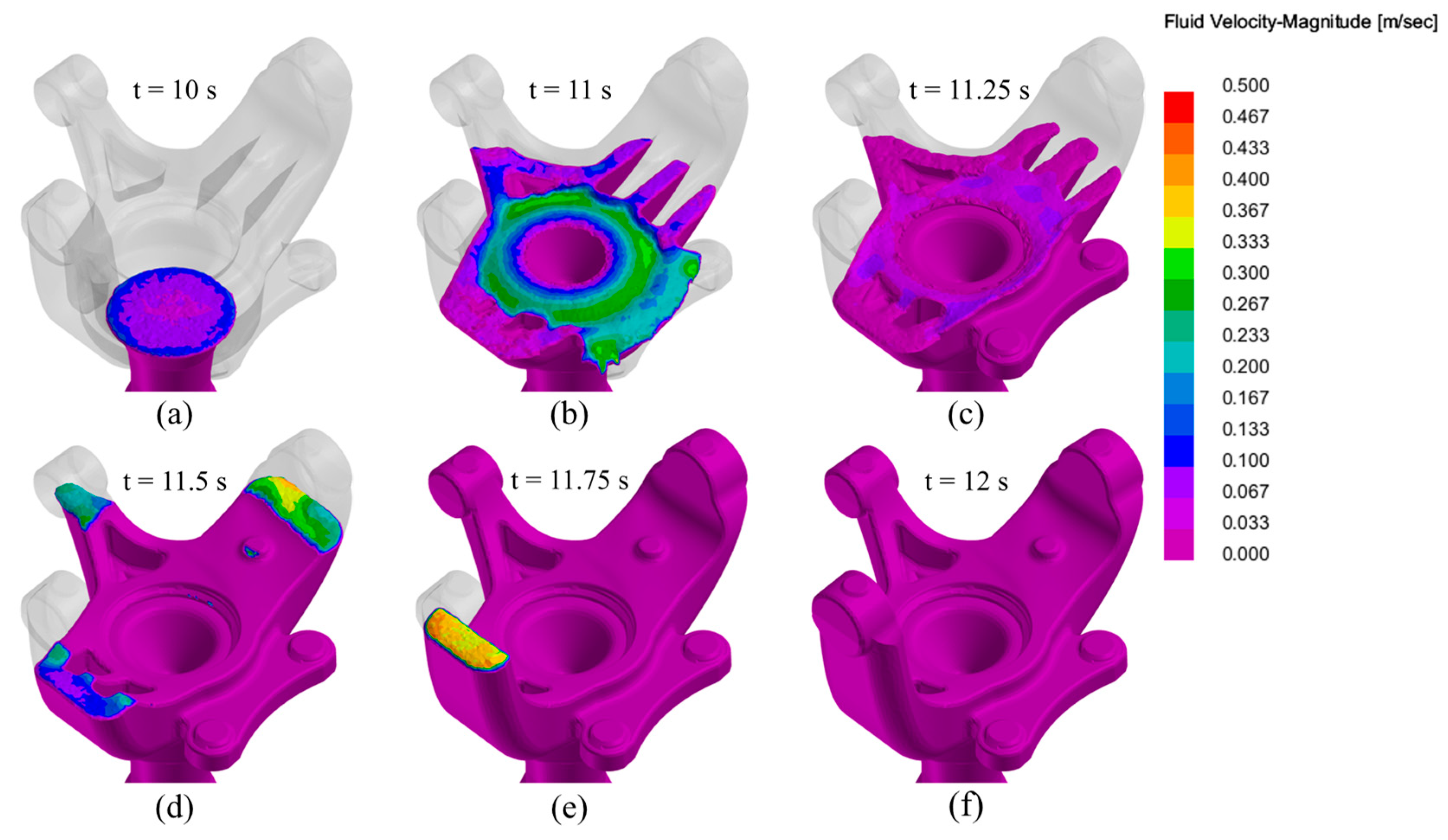



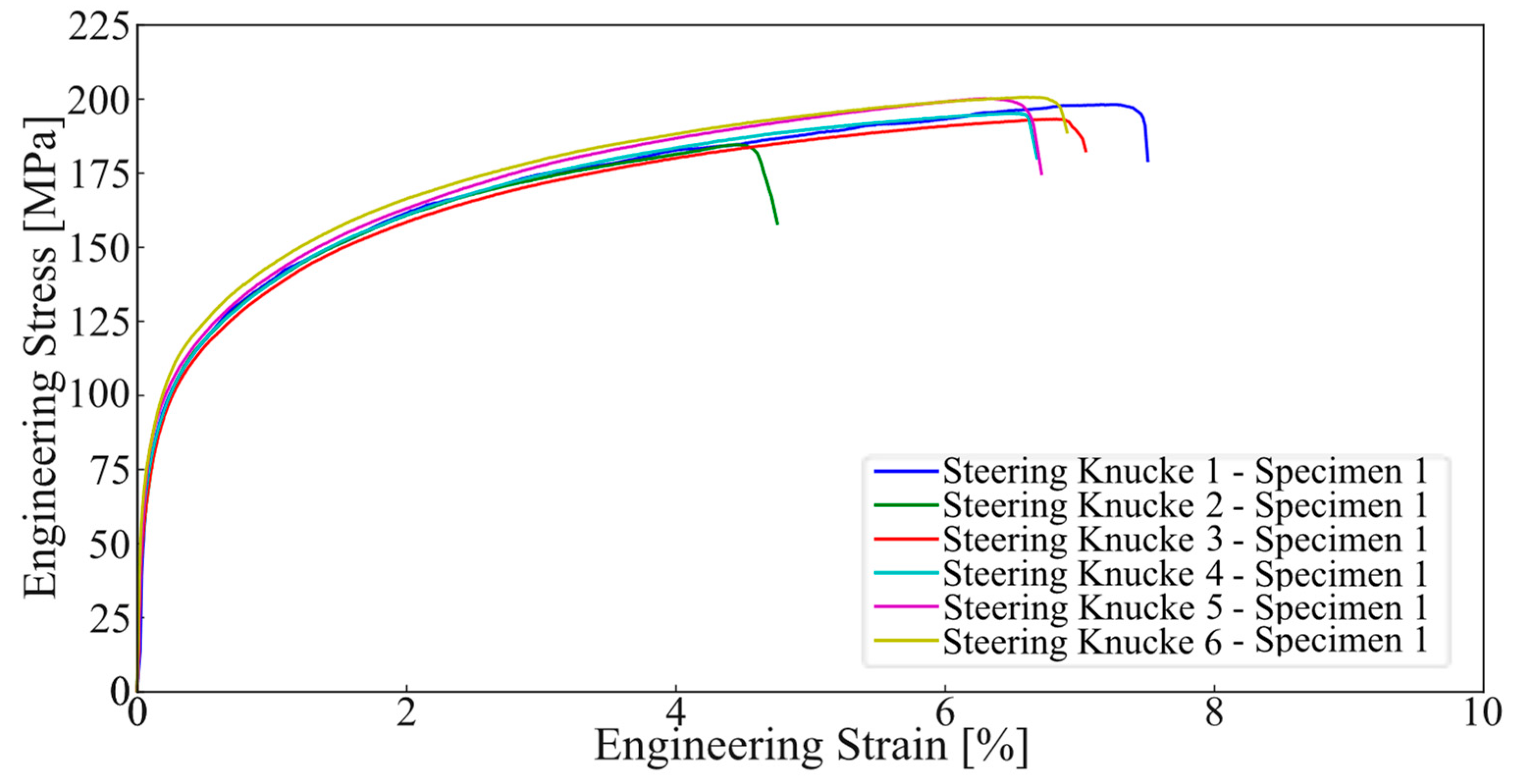
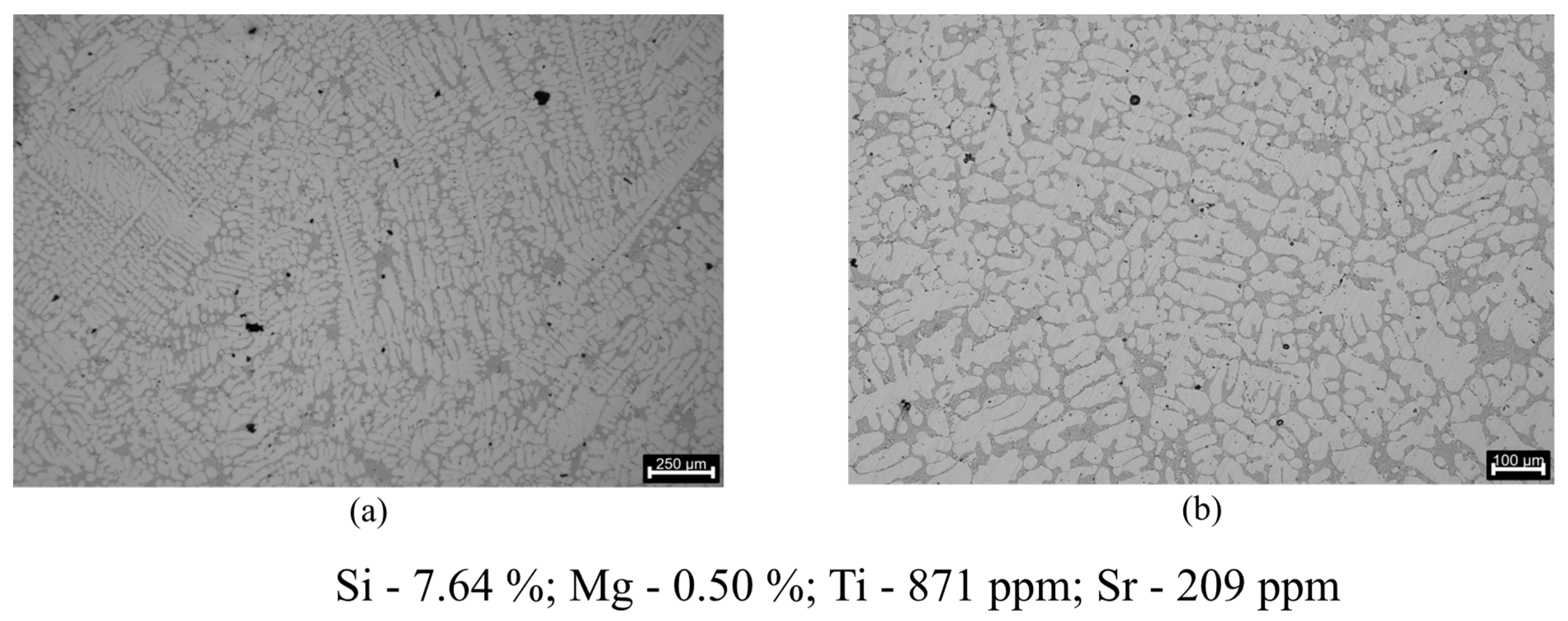
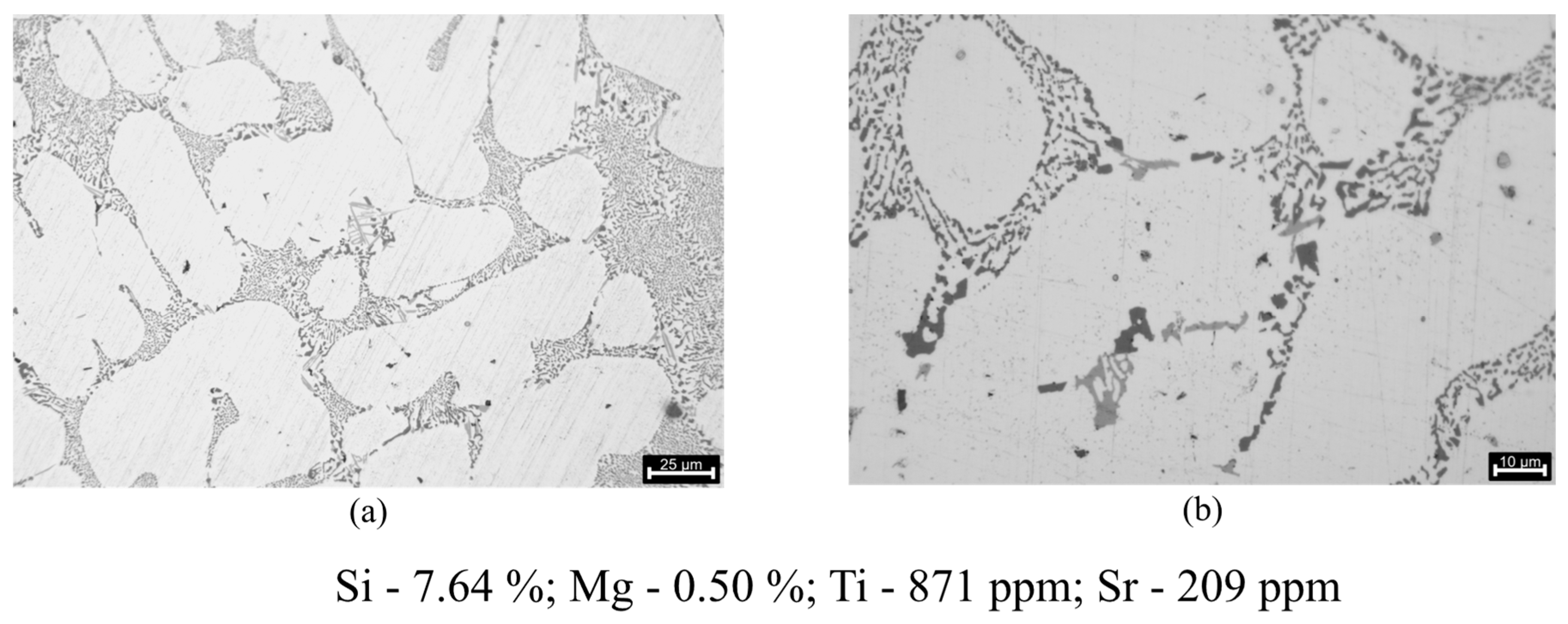
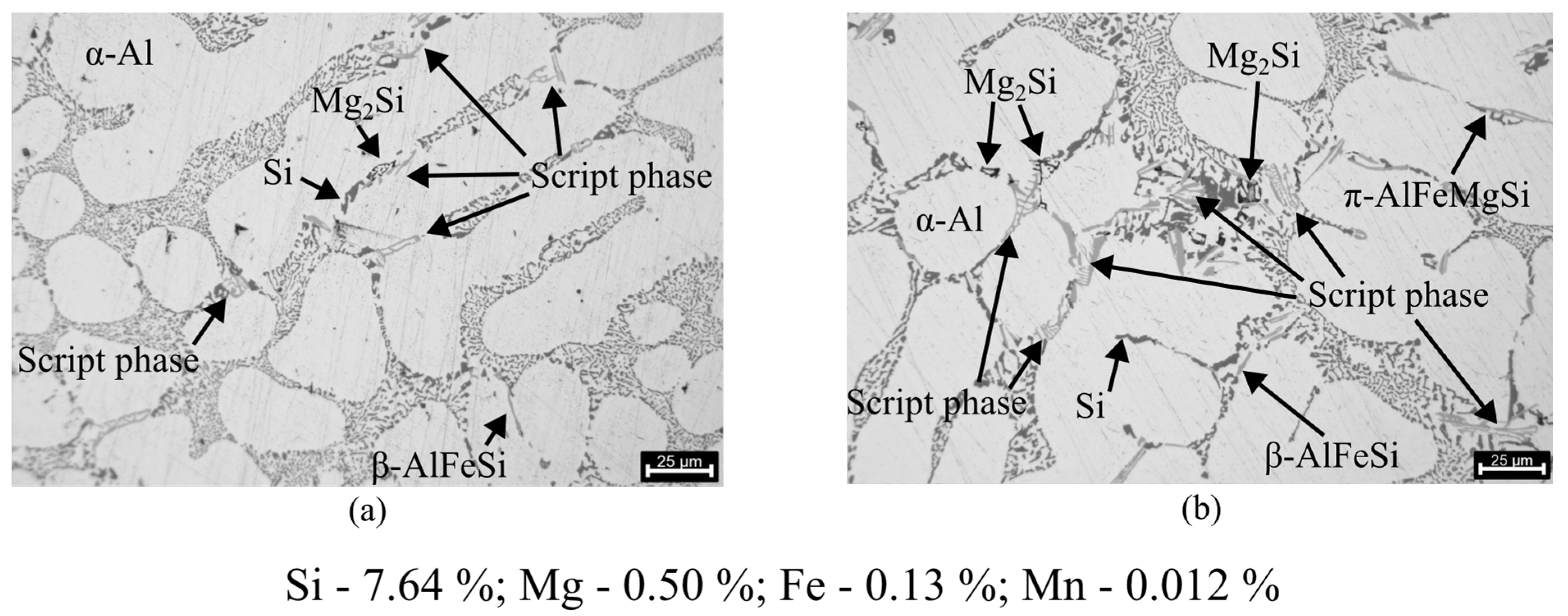
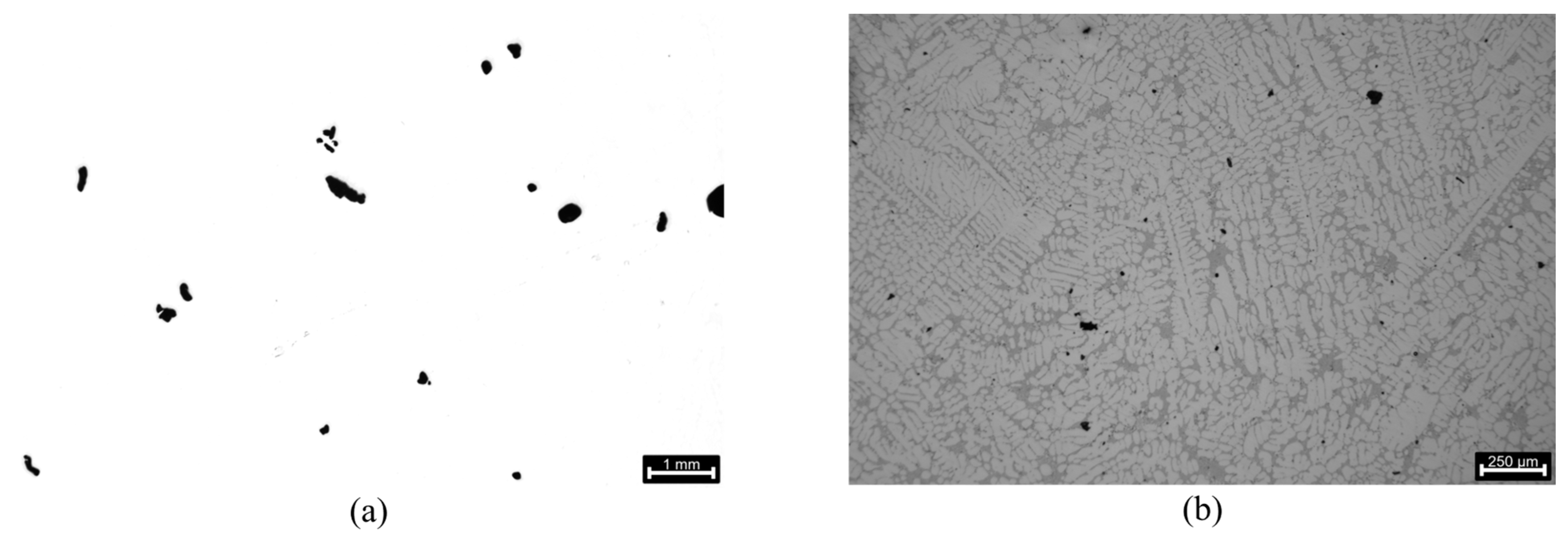
| Element | Si | Fe | Cu | Mn | Mg | Zn | Ti | Sr |
|---|---|---|---|---|---|---|---|---|
| Standard composition (%) 1 | 6.5–7.5 | 0.19 | 0.05 | 0.10 | 0.25–0.45 | 0.07 | 0.25 | - |
| Actual composition (%) | 7.64 | 0.13 | 0.03 | 0.12 | 0.50 | 0.01 | 0.09 | 0.02 |
| Tetrahedral Elements Size (mm) | |
|---|---|
| Riser tube insultation | 8 |
| Riser tube | 4 |
| Gating | 2 |
| Part | 2 |
| Bottom die | 8 |
| Top die | 8 |
| Ceramic insulation | 4 |
| Furnace | 8 |
| Volumes | Materials |
|---|---|
| Furnace | AlSi7Mg0.3 |
| Part | AlSi7Mg0.3 |
| Gating | AlSi7Mg0.3 |
| Riser tube | AlSi7Mg0.3 |
| Die | Steel H13 |
| Ceramic insulation | Monalite |
| Riser tube insulation | Refractory fused silica |
| Pouring temperature (°C) | |
| 720 | |
| Initial die temperature (°C) | |
| 350 | |
| Heat transfer coefficient (W/m2K−1) | Relationship |
| 20 | Riser tube–riser tube insulation |
| 20 | Furnace–riser tube Insulation |
| 300 | Die–ceramic |
| 300 | Part–ceramic |
| 300 | Gating–ceramic |
| 300 | Riser tube–ceramic |
| 500 | Ceramic–riser tube insulation |
| AlSi7Mg0.3–H11 1 | Die–part |
| Boundary Condition | Description |
| Inlet pressure | Definition of the pressure curves |
| Mould cooling | Definition of the die cooling mechanism |
| Exterior heat relationship | Definition of the temperature relationships between the simulation elements and the casting environment (free surface inside the die cavity and the contact of the die with the exterior) |
| Specimen | Yield Stress, Rp0.2 (MPa) | Ultimate Tensile Strength, Rm (MPa) | Total Elongation, At (%) |
|---|---|---|---|
| 1_1 | 94.83 | 197.91 | 9.01 |
| 1_2 | – | Invalid–extensometer slipped | – |
| 1_3 | 107.88 | 189.89 | 6.14 |
| 2_1 | 93.19 | 184.08 | 5.71 |
| 2_2 | 102.88 | 190.16 | 7.42 |
| 2_3 | – | Invalid–extensometer slipped | – |
| 3_1 | 93.48 | 193.20 | 8.46 |
| 3_2 | 95.73 | 184.26 | 6.48 |
| 3_3 | 98.49 | 193.46 | 8.33 |
| 4_1 | 94.13 | 194.83 | 8.02 |
| 4_2 | 91.99 | 194.91 | 7.98 |
| 4_3 | 99.66 | 196.20 | 8.16 |
| 5_1 | 93.33 | 199.71 | 8.06 |
| 5_2 | 99.79 | 198.91 | 8.66 |
| 5_3 | 96.14 | 201.58 | 9.06 |
| 6_1 | 102.33 | 200.33 | 8.29 |
| 6_2 | 99.73 | 200.12 | 9.36 |
| 6_3 | 103.99 | 198.85 | 7.99 |
| Yield Stress, Rp0.2 (MPa) | Ultimate Tensile Strength, Rm (MPa) | Total Elongation, At (%) | |
|---|---|---|---|
| LPDC-Average | 98.35 ± 4.32 | 194.90 ± 5.30 | 7.95 ± 1.01 |
| EN 1706 1 | 90–150 | 180–240 | 4–8 |
| Sample | Hardness (HBW) | |||
|---|---|---|---|---|
| Zone A | Zone B | Zone C | Average | |
| 1 | 73.3 | 77.1 | 72.6 | 74.3 ± 2.0 |
| 2 | 77.3 | 75.7 | 73.4 | 75.5 ± 1.6 |
| 3 | 74.6 | 78.0 | 77.8 | 76.8 ± 1.6 |
| 4 | 76.9 | 69.4 | 71.1 | 72.5 ± 3.2 |
| 5 | 77.5 | 77.6 | 78.4 | 77.8 ± 0.4 |
| 6 | 77.6 | 76.2 | 67.2 | 73.7 ± 4.6 |
| Total Average Hardness: | 75.1 ± 3.2 | |||
| Hardness (HBW) | |
|---|---|
| LPDC-Average | 75.1 ± 3.2 |
| EN 1706 1 | 50–65 |
| Sample | Porosity (%) | Average Pore Size (mm2) | Average Roundness |
|---|---|---|---|
| 1_1.25x_1 | 0.96 | 0.102 ± 0.086 | 0.49 ± 0.17 |
| 2_1.25x_1 | 0.30 | 0.043 ± 0.014 | 0.60 ± 0.23 |
| 3_1.25x_1 | 1.09 | 0.136 ± 0.075 | 0.61 ± 0.07 |
| 4_1.25x_1 | 0.25 | 0.043 ± 0.012 | 0.59 ± 0.19 |
| 4_1.25x_2 | 0.94 | 0.073 ± 0.041 | 0.65 ± 0.11 |
| 4_1.25x_3 | 0.40 | 0.050 ± 0.019 | 0.55 ± 0.15 |
| 4_1.25x_4 | 1.03 | 0.066 ± 0.039 | 0.71 ± 0.14 |
| 4_1.25x_5 | 0.74 | 0.045 ± 0.012 | 0.65 ± 0.20 |
| 5_1.25x_1 | 0.95 | 0.076 ± 0.061 | 0.56 ± 0.23 |
| 6_1.25x_1 | 0.59 | 0.072 ± 0.027 | 0.64 ± 0.16 |
| 6_1.25x_2 | 0.47 | 0.066 ± 0.019 | 0.49 ± 0.09 |
| 6_1.25x_3 | 0.73 | 0.058 ± 0.026 | 0.61 ± 0.14 |
| 6_1.25x_4 | 0.12 | 0.057 ± 0.015 | 0.47 ± 0.08 |
| 6_1.25x_5 | 0.12 | 0.060 ± 0.016 | 0.48 ± 0.10 |
Disclaimer/Publisher’s Note: The statements, opinions and data contained in all publications are solely those of the individual author(s) and contributor(s) and not of MDPI and/or the editor(s). MDPI and/or the editor(s) disclaim responsibility for any injury to people or property resulting from any ideas, methods, instructions or products referred to in the content. |
© 2024 by the authors. Licensee MDPI, Basel, Switzerland. This article is an open access article distributed under the terms and conditions of the Creative Commons Attribution (CC BY) license (https://creativecommons.org/licenses/by/4.0/).
Share and Cite
Monteiro, F.; Soares, G.; Madureira, R.; Silva, R.P.; Silva, J.; Amaral, R.; Neto, R.; Reis, A.; Esteves, A. Development of the Low-Pressure Die Casting Process for an Aluminium Alloy Part. Materials 2024, 17, 2835. https://doi.org/10.3390/ma17122835
Monteiro F, Soares G, Madureira R, Silva RP, Silva J, Amaral R, Neto R, Reis A, Esteves A. Development of the Low-Pressure Die Casting Process for an Aluminium Alloy Part. Materials. 2024; 17(12):2835. https://doi.org/10.3390/ma17122835
Chicago/Turabian StyleMonteiro, Filipe, Gonçalo Soares, Rui Madureira, Rui Pedro Silva, José Silva, Rui Amaral, Rui Neto, Ana Reis, and António Esteves. 2024. "Development of the Low-Pressure Die Casting Process for an Aluminium Alloy Part" Materials 17, no. 12: 2835. https://doi.org/10.3390/ma17122835
APA StyleMonteiro, F., Soares, G., Madureira, R., Silva, R. P., Silva, J., Amaral, R., Neto, R., Reis, A., & Esteves, A. (2024). Development of the Low-Pressure Die Casting Process for an Aluminium Alloy Part. Materials, 17(12), 2835. https://doi.org/10.3390/ma17122835














